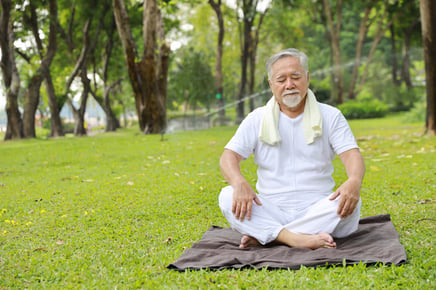 November marks COPD Awareness Month, a time to raise awareness of Chronic Obstructive Pulmonary Disease (COPD), a condition affecting millions worldwide. COPD is a chronic lung disease that makes it hard for air to move in and out of the lungs, making it hard to breathe. With COPD, everyday tasks can feel challenging, leaving many breathless and less motivated to stay active. While COPD is irreversible, regular exercise can help manage symptoms and improve quality of life.
November marks COPD Awareness Month, a time to raise awareness of Chronic Obstructive Pulmonary Disease (COPD), a condition affecting millions worldwide. COPD is a chronic lung disease that makes it hard for air to move in and out of the lungs, making it hard to breathe. With COPD, everyday tasks can feel challenging, leaving many breathless and less motivated to stay active. While COPD is irreversible, regular exercise can help manage symptoms and improve quality of life.
How Exercise Helps People with COPD
You might wonder, "How can exercise help me when breathing itself is already hard?", and that is a valid question! But here’s why exercise is essential for COPD management:
- Improved Oxygen Efficiency
Aerobic exercises (like walking, swimming, and cycling) help your body use oxygen more efficiently. The COPD Foundation states that although exercise won't increase lung capacity, it will strengthen the cardiovascular system and muscles, helping reduce shortness of breath and making daily activities easier. - Stronger Breathing Muscles
Exercise strengthens the muscles you use for breathing, including the diaphragm and the intercostal muscles. With stronger muscles, your body doesn’t have to work as hard to draw in oxygen, making breathing less of a strain (American Lung Association). - Increased Endurance
Regular aerobic and strength training exercises can boost your stamina, helping you perform tasks like walking, climbing stairs, or doing household chores with less fatigue. Over time, you'll find that you're able to exercise longer without feeling out of breath.
Top Exercises for COPD
- Aerobic Exercise
Swimming, walking and biking are great ways to improve your cardiovascular health and reduce the strain on your lungs. - Strength Training
Resistance exercises (using light weights, resistance bands, or bodyweight exercises) help build muscle strength, which make daily activities easier, and improve posture which can also help to make breathing easier. - Breathing Exercises
Practicing breathing exercises and can help reduce shortness of breath and improve your exercise tolerance. These exercises slow down your breathing and make it easier to exhale fully (American Lung Association).
While exercise is beneficial, it's important to exercise safely. Here are some tips to keep in mind:
- Consult with a healthcare professional before starting any exercise program, especially if you have severe COPD or other health conditions.
- Start slow and gradually increase the intensity.
- Use your prescribed medications.
- Stay hydrated and avoid exercising in extreme weather conditions like high heat or cold, which can aggravate COPD symptoms.
Living with COPD can feel challenging, but you don’t have to do it alone. NIFS group fitness classes offer a variety of ways to help you stay active safely and effectively, with options designed to strengthen your body, improve your endurance, and help you breathe easier. Join us to discover a supportive environment where you can manage your health and find renewed energy for the things you enjoy. Start your journey to better breathing and a fuller life today—let NIFS help you take that first step.


 It has often been thought that core strength can only to be achieved through sit ups, crunches, and planks but in recent years there has been a lot more discussion about the way we breathe and how it effects our core. If you participate in 1-1 training or group fitness, you have probably heard your trainer tell you to breathe and brace your core through a particular exercise. What does it mean to effectively brace your core and why is it important? Is it to see your abdominals, provide you strength or to help with your posture? In all reality, we use our core for many daily tasks such as standing tall, getting up off a chair, or even walking. Learning how to brace your core is fundamental in creating a strong foundation for all movements and can also help to aide in injury prevention.
It has often been thought that core strength can only to be achieved through sit ups, crunches, and planks but in recent years there has been a lot more discussion about the way we breathe and how it effects our core. If you participate in 1-1 training or group fitness, you have probably heard your trainer tell you to breathe and brace your core through a particular exercise. What does it mean to effectively brace your core and why is it important? Is it to see your abdominals, provide you strength or to help with your posture? In all reality, we use our core for many daily tasks such as standing tall, getting up off a chair, or even walking. Learning how to brace your core is fundamental in creating a strong foundation for all movements and can also help to aide in injury prevention.